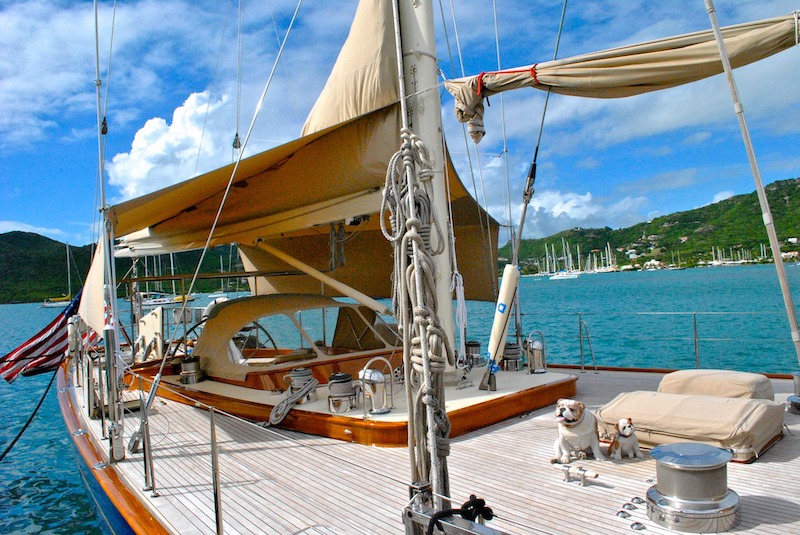Antigua and Barbuda
A magical pair of Caribbean islands with beautiful beaches and amazing waters to dive in, Antigua and Barbuda are perfect for a tropical trip.
Antigua and Barbuda travel guide
It’s great to know there are still paradise islands that are completely untouched, where you can feel as if you’ve stepped into the story of Treasure Island or escaped your everyday world entirely. We’re talking about Antigua and its even more unspoilt sister, Barbuda, home to enough beaches to visit in a year of exploring, each more exquisite than the last. The snorkelling and diving options here are exceptional, and the selection of water sports are endless, too.
Antigua, the larger of the 2 islands, is home to English Harbor, where the meticulously restored 18th century Nelson’s Dockyard is located, with a number of historic churches and old forts nearby. The island’s main town is St John’s, filled with maritime history. There are other charming tiny villages to explore and in the interior you’ll find a small tropical rainforest, ancient Native American archaeological sites and refurbished sugar mills.
Barbuda is located 42km from Antigua, a small island with 27km of gorgeous unspoilt beaches along its coastline, many a haven for nesting turtles, terns and frigate birds. Aside from the small main town, Codrington, there are a few guest houses to stay in on the island. Spend time birdwatching on beautiful Pink Beach, visit caves and sinkholes or go diving to explore around 200 shipwrecks. Barbuda’s only historic ruin is the 18th century Martello Tower, built by the Spanish. Another great sight to visit is the Frigate Bird Sanctuary, home to around 400 species of birds.
Antigua is possibly the most representative of the current concept of a tiny Caribbean location. With no other significant natural resources, tourist trade is the mainstay of both islands' economies. Beautiful beaches await and a huge amount of paradise feels will consume you as you lay on the stunning white sand, and there are many of high-end resorts on Antigua. The beaches are still there, but there isn't much in the way of tourism infrastructure in Barbuda.
Cricket is a popular sport in this country, and it has produced some true all-time world champions. Cricket enthusiasts will have plenty of opportunities to mingle with the locals.
The official language is English, although local languages are also spoken. There's now a growing migrant community that speak Spanish.
Fungie (pronounced foon-gee) and pepper pot are the national dishes. Fungie is a cornmeal-based delicacy that is quite similar to Italian Polenta. Ducana, seasoned rice, saltfish, and lobster are some of the other indigenous cuisines (from Barbuda). Sugarcake, fudge, raspberry and tamarind stew, and peanut brittle are among the local delicacies. Local and foreign cuisine is available at the island's many eateries.
On Saturday, expect a slew of drive-by barbecues at key traffic crossings around the island. Rice plus chicken, dumplings, stew, and other dishes are on the menu. For enjoyment, they may even feature a sound system.
The people in the area are really nice and respectful. If you approach them politely, they will very certainly return it to you. Please, thank you, and good afternoon should all be remembered as you greet somebody with a smile.

Spend some time on the water with a spot of sailing while in Antigua and Barbuda.
Best time to visit: Come in the winter off-season months, May to November, when travel is less expensive. It’s less rainy from December to April, but this is peak season and the islands are crowded at this time.
Best Area for Sightseeing: To help you decide where to explore, see Things to do in Antigua & Barbuda below.
Shopping in Antigua & Barbuda: St John’s on Barbuda offers 2 shopping areas near the waterfront – the modern Heritage Quay as well as historic Redcliffe Quay, both offering duty free stores selling souvenirs, handicrafts and other items. For more traditional goods and fabulous fresh produce, visit the St John’s Public Market.
Food & Restaurants in Antigua & Barbuda: To cater to visitors, both islands offer various cuisines in beachfront bars, restaurants and at resort eateries. Local cuisine is a combination of Creole and British dishes, and the seafood is superb.
Nightlife: Beachside bars and eateries are great places to visit at night, and in St John’s and along Dickenson Bay in Antigua, nightlife offerings abound.
Beaches: Both islands boast beautiful beaches, all with pretty pink sand. Popular choices include Dickenson Bay, spectacular Half Moon Bay National Park and Long Bay, which is more secluded. Along Antigua’s south-west coastline you’ll find Darkwood Beach and if you head for Deep Bay Beach, you dan see a shipwreck in the shallows. Galleon Beach is where numerous boats anchor and the 4 beaches at Hawksbill Bay include a nudist beach called Eden Beach. There’s also white sand Turner’s Beach on Antigua’s south-west coast. Head further afield to Great Bird Island, 3km off Antigua’s mainland, to enjoy its magnificent beaches.
Things to do in Antigua & Barbuda:
- Go birdwatching between August and February on Codrington Lagoon.
- Attend an international regatta.
- Explore the Nelson’s Dockyard Museum to learn about the UNESCO-listed naval dockyard’s history.
- Soak up the sun on 17km of untouched beaches on the island of Barbuda.
- Visit the Anglican Cathedral of St John the Divine.
- Discover Antigua’s first sugar plantation, Betty’s Hope.
- Shop till you drop in Heritage Quay.
- Discover the islands’ history at the Museum of Antigua and Barbuda.
Best way to get around: Take the bus or rent a car to explore. You can also take a taxi on Antigua.
Best Area for Families: Saint Mary, Antigua This west coast town offers several accommodation options. It is close to numerous untouched beaches that are safe for swimming and offer various water sports.
